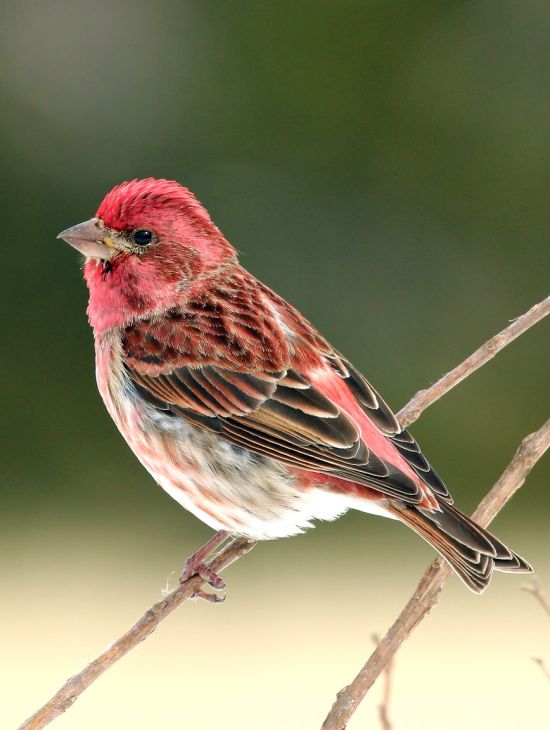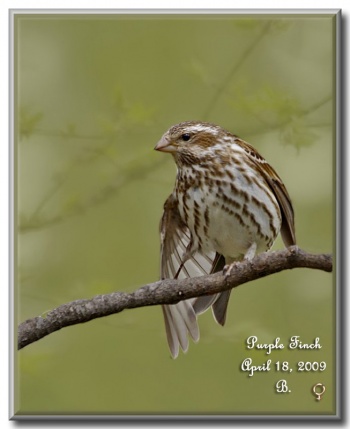- Haemorhous purpureus
Carpodacus purpureus
Identification
6 ins (15.5 cm)
Male
- Raspberry red on head, breast, back and rump
- Streaked back
Female
- Light brown upperparts
- White underparts with dark brown streaks
- White supercilium
Like the House Finch, it has a rare golden-yellow variant of the normal red plumage.
Similar Species
House Finch has brown streaks on belly, less red on head, smaller bill, longer tail, and different call. Cassin's Finch has a paler throat and breast, streaked undertail coverts, and larger bill.
Distribution
Canada and both the western and eastern United States. Winters south as far as the U.S.-Mexico border.
Taxonomy
Formerly placed in genus Carpodacus.
Subspecies
This is a polytypic species consisting of two subspecies:1
- H. p. purpureus: (Eastern) (Gmelin, 1789):
- H. p. californicus (Western) (S. F. Baird, 1858):
- South-western British Columbia to south-western US and northern Baja California
Habitat
Coniferous and mixed forest, as well as various wooded areas along the U.S. Pacific coast.
Behaviour
They have been displaced from some habitat by House Sparrows and then the introduction of House Finches in the east.
Diet
They forage in trees and bushes, sometimes in ground vegetation. They mainly eat seeds, berries, buds and blossoms, usually from outer branches of trees and sometimes from the ground.
Breeding
The nest, a cup of twigs and grass and usually lined with hair, is built in a conifer. The 3-5 light greenish blue eggs, are marked with brown and black; they are incubated for 13 days by the female.
Vocalisation
Song is a mellow, rich warbling.
Call is a sharp pik in flight.
Listen to a Purple Finch song clip
Recording © by Joseph Morlan
Pacifica, California, 02 May 2020
In Culture
This is the state bird of New Hampshire.
References
- Clements, J. F., T. S. Schulenberg, M. J. Iliff, S. M. Billerman, T. A. Fredericks, B. L. Sullivan, and C. L. Wood. 2019. The eBird/Clements Checklist of Birds of the World: v2019. Downloaded from http://www.birds.cornell.edu/clementschecklist/download/
- ITIS Standard Report Page: Carpodacus purpureus its.gov
- Wootton, J. T. (2020). Purple Finch (Haemorhous purpureus), version 1.0. In Birds of the World (A. F. Poole and F. B. Gill, Editors). Cornell Lab of Ornithology, Ithaca, NY, USA. https://doi.org/10.2173/bow.purfin.01
- Clement, P. (2020). Purple Finch (Haemorhous purpureus). In: del Hoyo, J., Elliott, A., Sargatal, J., Christie, D.A. & de Juana, E. (eds.). Handbook of the Birds of the World Alive. Lynx Edicions, Barcelona. (retrieved from https://www.hbw.com/node/61387 on 24 April 2020).
Recommended Citation
- BirdForum Opus contributors. (2024) Purple Finch. In: BirdForum, the forum for wild birds and birding. Retrieved 20 April 2024 from https://www.birdforum.net/opus/Purple_Finch
External Links







